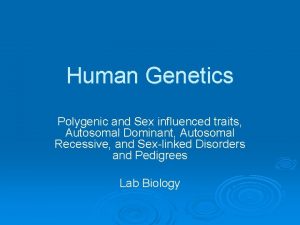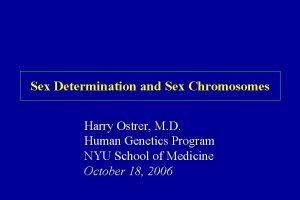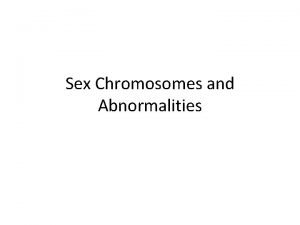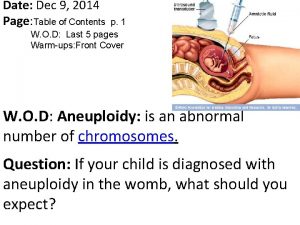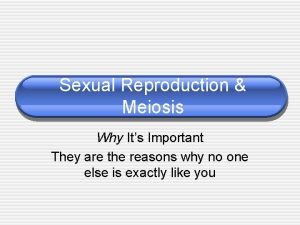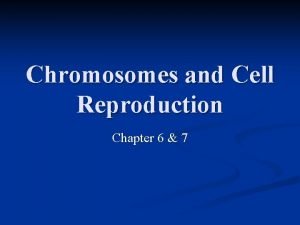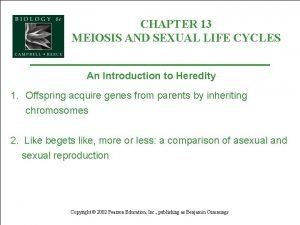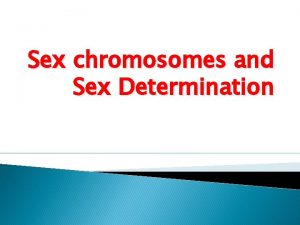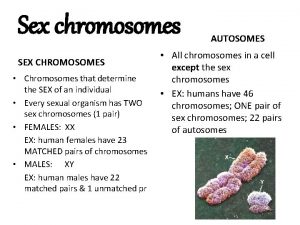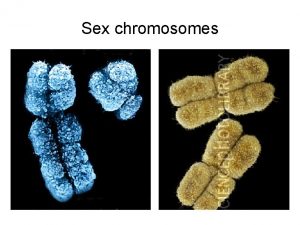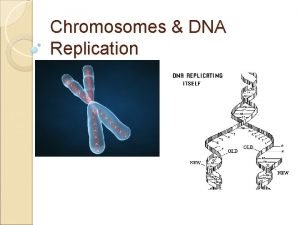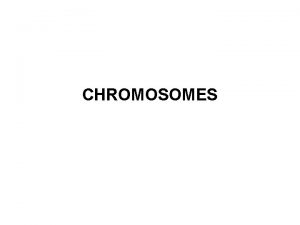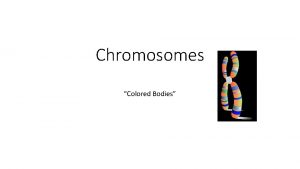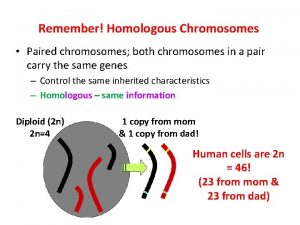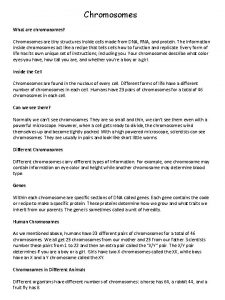Sex Determination and Sex Chromosomes CHAPTER CONCEPTS Sexual



![[5. 1 Sexual Differentiation and Life Cycle Chlamydomonas Maize (Zea mays) C. elegans] 5. [5. 1 Sexual Differentiation and Life Cycle Chlamydomonas Maize (Zea mays) C. elegans] 5.](https://slidetodoc.com/presentation_image_h2/46300cbd60074d1c5bfbf29a584aa842/image-4.jpg)


























- Slides: 30

Sex Determination and Sex Chromosomes

CHAPTER CONCEPTS Sexual differentiation plays an important role during the life cycle of various plants and animals. While a single pair of sex chromosomes (e. g. , the X and the Y chromosome) often plays an important role in determining sexual maturation, genes present on these chromosomes as well as on autosomes sever as the underlying basis of sex determination.

In humans, genes on the Y chromosomes cause maleness, and in their absence, female development occurs. Mechanisms have development to compensate for the dosage of genetic expression in organisms where one sex contains two X chromosomes is the compensatory mechanism. Still other modes of sex determination have evolved. Reptiles exemplify environmentally induced sex determination, where the temperature during the incubation of eggs is the critical factor.
![5 1 Sexual Differentiation and Life Cycle Chlamydomonas Maize Zea mays C elegans 5 [5. 1 Sexual Differentiation and Life Cycle Chlamydomonas Maize (Zea mays) C. elegans] 5.](https://slidetodoc.com/presentation_image_h2/46300cbd60074d1c5bfbf29a584aa842/image-4.jpg)
[5. 1 Sexual Differentiation and Life Cycle Chlamydomonas Maize (Zea mays) C. elegans] 5. 2 X and Y Chromosomes: Early Studies 5. 3 Chromosome Composition and Sex Determination in Humans Klinefelter and Tumer Syndromes 47, XXX Syndrome 47, XYY Condition Sexual Differentiation in Humans

5. 4 Sexual Differentiation in Humans The Y Chromosome and Male Development 5. 5 The Sex Ratio in Humans 5. 6 The X Chromosomes and Dosage Compensation Barr Bodies The Lyon Hypothesis The Mechanism of Inactivation 5. 7 Chromsome Composition and Sex Determination in Drosophila 5. 8 Temperature Variation and Sex Determination in Reptiles

v Sex Determination v Sexual differentiation

The Chromosome Theory of Inheritance v Sutton and Boveri’s chromosome theory of inheritance proposed in 1902— Genes are located on chromosomes Ø sex chromosomes : the X and Y chromosomes Ø autosomes : all other chromosomes are called.

ØSex Determination and Sex Chromosome • heteromorphic chromosomes, such as the X-Y pair. • Genes rather than chromosomes determine sex. • Some of these genes are present on sex chromosomes, but others are autosomal.

5. 1 Sex Determination and Sex Chromosome Ø XO mode (The Protenor mode ) • • • Female—XX Male—X Occurs in some insects like grasshoppers Ø XY mode (The Lygaeus mode) • • • Female—XX (homogametic sex) Male XY (heterogametic sex) Occurs in Drosophila, mammals and some plants in both cases

Figure 5. 4 (a)The Protenor mode of sex determination where the heterogametic sex is XO and produces rgametes with or without the. X chromosome.

(b)The Lybaeus mode of sex determination, where the heterogametic sex is XY and produces gametes with either an X or a Y chromosome.

Ø ZZ-ZW System • Female—XY (heterogametic sex) • Male—XX (homogametic sex) • Occurs in birds, butterflies and some fishes

5. 3 Chromosome Composition and Sex Determination in Humans Klinefelter and Tumer Syndromes 47, XXX Syndrome 47, XYY Condition Sexual Differentiation in Humans

Figure 5. 5 The traditional human karyotypes derived from a normal female and a normal male.

Kleinfelter’s Syndrome (47, XXY) • Due to nondisjunction of X chromosome in male or female parent • Incidence: 1/1000 male births • Tends to be maternal age effect • Sometimes have more than two X chromosomes • Phenotypic features a. Long arms b. Breast development c. Little or no sperm production d. Small testes e. Usually mentally retarded

Turner’s Syndrome in humans (45, XO) • Due to nondisjunction in male or female parents to produce gametes without X chromosome • Incidence: 1/5000 female births • High proportion of spontaneous abortions are Turner’s and most Turner’s individuals are aborted • Phenotypic features: a. b. c. d. Short stature Webbed neck—web of skin between neck and shoulders Breast development absent or nearly so Some cognitive functions affected, but intelligence often about normal e. Pubic and axillary hair reduced or absent f. Infantile genitalia g. Usually sterile

Figure 5. 6 The karyotypes of individuals with (a) Klinefelter syndrome (47, XXY) and (b) Turner syndrome(45 X).

XYY Condition • Due to nondisjunction of Y chromosome in male • Incidence: 1/1000 male births • Phenotypic features: a. Above average height b. Fertile c. Sometimes (but not always) retarded d. May be correlation with delinquency

Poly-X Females (XXX, XXXXX, …) • Incidence: 1/1000 female births • • Maternal age effect Phenotypic features: a. Sometimes infantile genitalia b. Sometimes underdeveloped breasts c. Fertile d. Sometimes mental retardation e. Incidence increases with increasing number of X chromosomes

Sexual Differentiation in Humans ØThe Y Chromosome and Male Development • Some region of the Y chromosome encodes a gene product that somehow triggers the undifferentiated gonadal tissue of the embryo to form testes. This product is called the testis-determining factor (TDF). • A small part of the short arm of the human Y chromosome contains a gene called SRY (sex determining region Y) that encodes TDF.

Figure 5. 7 The various regions of the human Y Chromosome

5. 5 The Sex Ratio in Humans Given the potential for producing equal numbers of both sexes, the actual proportion of male to female offspring has been investigated and is referred to as the sex ratio. Ø The primaiy sex ratio reflects the proportion of males to females conceived in a population. Ø The secondary sex ratio reflects the proportion of each sex that is born. The secondary sex ratio is much easier to determine, but has the disadvantage of not accounting for any disproportionate embryonic or fetal mortality.

5. 6 The X Chromosomes and Dosage Compensation Barr Bodies The Lyon Hypothesis The Mechanism of Inactivation

Figure 5. 8 Photomicrographs comparing cheek epithelial cell nuclei from a male that fails to reveal Barr bodies (bottom)with a female that demonstrates Barr bodies (indicated by the arrow in the top image).

Figure 5. 9 Barr body occurrence in various human karyotypes, where all X chromosomes except one (N-1) are inactivated.

Figure 5. 10 A calio cat (a), where the random distribution of orange and black patches demonstrates the Lyon hypothesis.

5. 7 Chromsome Composition and Sex Determination in Drosophila • In Drosophila males are XY and females XX • In Drosophila sex is determined by the ratio of autosomes to X-chromosomes: An X to one set of autosomes = male, two Xs = female • femal • metafemale • metamales • intersexs

Figure 5. 11 Chromosomes compositions, the ratios of X chromosomes to sets of autosomes and the resultant sexual morphology in Drosophila melanogaster.

5. 8 Temperature Variation and Sex Determination in Reptiles

Figure 5. 12 Three different patterns of temperaturedependent sex determination (TSD) in reptiles. • Three different patterns of temperature-dependent sex determination (TSD) in reptiles. • The relative pivotal temperature Tp is crucial to sex determination during a critical point in embryonic development.
 Sex linkage
Sex linkage Heterogametic
Heterogametic Sex determination and sex linkage
Sex determination and sex linkage Sex sex sex
Sex sex sex Sex snv
Sex snv Xxtesticles
Xxtesticles Sex sex sex
Sex sex sex Sex sex sex
Sex sex sex Autosomes and sex chromosomes
Autosomes and sex chromosomes Brain pop sex ed
Brain pop sex ed Sex determination punnet square
Sex determination punnet square Triploidy syndrome
Triploidy syndrome Lyon hypothesis
Lyon hypothesis Autosomes vs sex chromosomes
Autosomes vs sex chromosomes Genes located
Genes located Autosomes vs sex chromosomes
Autosomes vs sex chromosomes How many chromosomes are in a human’s sex cells?
How many chromosomes are in a human’s sex cells? Reproduction of organisms
Reproduction of organisms Campbell biology concept check answers
Campbell biology concept check answers Once a sex offender always a sex offender
Once a sex offender always a sex offender Chapter 6 chromosomes and cell reproduction
Chapter 6 chromosomes and cell reproduction Pedigree miscarriage symbol
Pedigree miscarriage symbol Chapter 10 sexual reproduction and genetics
Chapter 10 sexual reproduction and genetics виды проектов
виды проектов Chapter 13 meiosis and sexual life cycles
Chapter 13 meiosis and sexual life cycles Sexual reproduction
Sexual reproduction Quality control standards
Quality control standards Price and output determination under oligopoly
Price and output determination under oligopoly Spi in software engineering
Spi in software engineering Price determination under monopolistic competition
Price determination under monopolistic competition Exchange rate determination and forecasting
Exchange rate determination and forecasting








